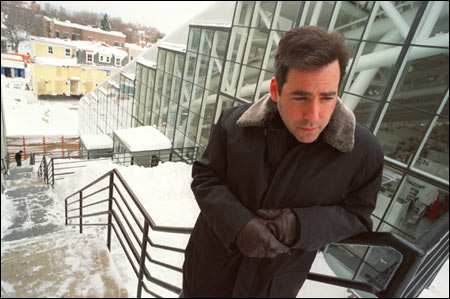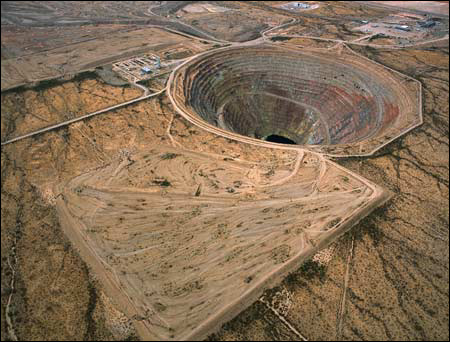Professor presents hideous flip side of Western sublime :
Berger’s new book is “Reclaiming the American West”

Alan Berger has been called the anti-Ansel Adams.
While Adams sought out the most spectacular scenery in the American West and photographed it in ways that exclude all signs of human interference, Berger does just the opposite. He seeks out those parts of the Western landscape that no one wants to look at – the vast terraced pits of abandoned gold and copper mines, the mountains of slag and tailings, the pools of cyanide.
Berger, who joined the faculty of the Graduate School of Design (GSD) as an associate professor of landscape architecture this January, presents the hideous flip side of the Western sublime in a new book, “Reclaiming the American West” (Princeton Architectural Press, 2002).
A coffee-table book in format if not in content, the volume contains 187 full-color illustrations, including many aerial photos of mining sites in the Intermountain West, a huge area comprising Idaho, Wyoming, Colorado, Nevada, Utah, Arizona, and New Mexico.
The book grew out of Berger’s attempt to understand the Western landscape. An Easterner who grew up in Stamford, Conn., he took a job teaching landscape architecture at the University of Colorado in Denver. The summer before classes started, he drove 3,000 miles in one week, camping out in national forests, and seeing as much of the West as he could.
One evening, he set up camp in the San Juan Mountains of Southwestern Colorado, not realizing he was on the edge of the Summitville gold mine, an open-pit mine that used cyanide to extract gold from low-grade ore. Soon after the mine began operation in 1984, toxic chemicals leaching into surrounding water caused one of the worst environmental disasters in the history of the area. It was the scene of this disaster that greeted Berger the next morning.
“It was a type of landscape I had never experienced before – the biggest altered terrain you could imagine, and there it was right before my eyes.”

That experience put the West into perspective for Berger as nothing else had.
“It became clear to me that we were creating environmental disasters as a result of our consumptive lifestyle – and I realized I had a research project.”
In order to better understand his subject, Berger took to the air, hitching rides with the Colorado State Highway Patrol as they flew over the Denver area conducting radar scans to catch speeding motorists. He also flew with federal inspectors monitoring coal mines for signs of potential landslides. These reconnaissance flights produced many of the aerial photos that appear in the book.
As Berger familiarized himself with the topography of the West and delved into its history, he realized that the alteration of the landscape was built into the very legislation that governed the great westward expansion.
“The federal mechanisms to distribute land in the West all advocated alteration of the landscape. The West has always had that embedded in it,” he said.
The activity that altered the landscape most profoundly was mining. It has been estimated that almost all of our mineral resources and most of our energy resources are produced west of the 100th meridian.
Another important factor is that about 50 percent of the Intermountain West is owned by the federal government, which leases that land to large mining companies for energy exploration. This means that as fossil fuels become scarcer and demand grows, a huge percentage of the West may be transformed by mining operations.
For many years, the enormous craters and canyons produced by mining were allowed to remain just as the earth-moving machines had left them. Then, in the 1960s and ’70s, public pressure compelled the federal government to pass legislation mandating the reclamation of lands altered by mining. Today, numerous laws, both federal and state, require mining companies to reclaim land they have altered.
But reclamation, Berger points out, is not the same as restoration.
“Reclamation acknowledges that the landscape can’t be returned to its original state. Instead, it turns into a third state – the reclaimed landscape.”
In the case of coal mines, the federal law states that the landscape must be returned to its “approximate original contours.” In surface coal mines – huge trenches across the face of a coal seam – the mining company often fills in the depleted trench as the operation progresses. The result rarely resembles what the landscape looked like originally, even though vegetation soon covers up evidence that the earth has been disturbed.
What is alarming is the extent of this reclamation. It has been estimated that by the time all its coal is mined out – some time in the second decade of the century – Wyoming alone will have 40,000 square miles of reclaimed coal mines.
Mineral mines are another matter. Often thousands of feet deep and miles in circumference, they are simply too big to be filled in.
Even with mandated reclamation, the stories of major mining operations do not always end happily. Companies may evade their responsibilities by declaring bankruptcy, as a gold mining company did in Montana, walking away from 36 mines, then reorganizing under a different name and opening new ones.
In the past, the Superfund was able to deal with such cases, but President Bush’s promise to veto legislation that would reauthorize the fund may eliminate this option.
“With the Superfund going away, there will be many more environmental disasters, which will need the attention of scientists and designers,” Berger said.
Berger does not believe that the goal should necessarily be to restore the landscape in such a way that the scars become invisible. Such an approach is dishonest and possibly dangerous, he said.
“When a reclaimed mine blends in with the landscape, some say it’s a success. I say it’s deceiving. No one is going to know what happened there. Just because something looks good doesn’t mean it’s good for us.”
The problem is not only that reclamations may inadequately protect the public from toxic chemicals. There is also a dangerous fallacy in the philosophy behind reclamation.
“If you can justify destroying the environment by saying we’ll make it blend back in, that translates into open-ended destruction – we’ll destroy everything.”
Berger advocates an open-ended ecological approach to designing with altered sites, in which the landscape is reclaimed more slowly, allowing it to heal itself, and allowing the remnants of mining operations to remain visible.
“I’m not saying let’s leave them all, but let’s leave some examples. If we can make a link between our consumption of resources and the destruction of the landscape, then maybe it would help us to understand ecology better.”




